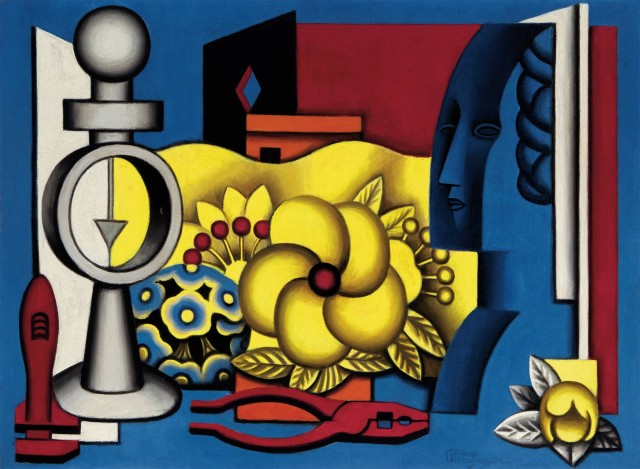Jean Metzinger: Two Sides of a Cubist
11/07/2017 Old Master Paintings

NEW YORK, NY -- Jean Metzinger's earliest paintings were essays in vibrant color that placed him firmly among the Fauve painters, with whom he began to exhibit in 1903. He soon was attracted to pointillism, a technique in which the artist systematically applied paint with individual strokes in contrasting hues, which the viewer's eye would then perceive as a blended whole. Metzinger's paintings in this vein are often strongly geometrical, built up with large brushstrokes of brilliant color. This mosaic-like approach to composition quickly led him toward Cubism, which he embraced enthusiastically in 1908, both as an artist and as a theorist.
Metzinger began writing about Cubism only shortly after he began to paint in the style. His first essay on the subject, Note sur la peintre (A Note on Painting), was published in 1910. Here he described Cubism not just as a style, but as a philosophy of perception, in which "enlightened" contemporary artists -- he mentioned Picasso, Braque and Delaunay by name -- had rejected the "stability" of traditional forms to stand "poised between a pursuit of the transient and a passion for the timeless." He contrasted Cézanne and Picasso, describing Cézanne as a maker of "forms alive in the reality of light," while Picasso depicted their ״real life in the mind." This he accomplished by showing objects from several points of view in a "free, mobile perspective" that revealed the "entire geometry" of each. It is interesting to note that Metzinger's observations are almost identical to those made by historians of Cubism today. Thus, he was not only the movement's first theorist, he was to become, along with Albert Gleizes, with whom he would later collaborate on another important treatise, one of its definitive voices.
Metzinger's earliest cubist paintings closely resemble the Analytical cubist works of Picasso and Braque, with their faceted forms, muted palettes, and overlapping planes. In a few years, however, his work began to evolve toward the next phase of the style, known as Synthetic Cubism, which featured flattened forms and brighter colors. Unlike Analytical works, in which objects were "analyzed" by being broken up into component shapes, in this new phase the artist brought together smaller forms to "synthesize" a larger image.
The First World War brought much of this development to a halt. Some artists served in the army -- Braque and Forain were badly injured -- but even for people who were not actually in the trenches, the sheer brutality and the catastrophic destruction of the conflict were a profound shock. The result was that during the years following and through the 1920s, many European artists, recoiling from the mechanized horrors of the war -- the dark side of what had once seemed a thrilling modernity -- rejected the avant-garde movements that had flourished before it. There was a widely felt desire to return to the reassuring forms of tradition. Many artists, including the father of Cubism himself, Picasso, embraced a style of calm classicism. Others, such as Fernand Léger and the artists at the Bauhaus School in Dessau, Germany, not prepared to turn away from abstraction altogether, embraced machinery as an aesthetic ideal. As László Moholy-Nagy, a professor at the Bauhaus School, wrote in 1922, “This is our century. Technology, the machine, socialism. Make your peace with it." Metzinger fell into this second group.
A good example of the "mechanical" style of the 1920s is Metzinger's Nature Morte (Still Life), of circa 1929. Here we can see the bright colors and flat planes so characteristic of Synthetic Cubism, but instead of building up a single image from smaller pieces, this work presents a group of discreet objects, some of them quintessentially mechanical -- a wrench, a pair of pliers, a freestanding dial -- together with flowers and various geometrical forms that appear to have been cut from sheet metal. Although the flowers at first seem to represent an organic counterpoint to the tools and metallic shapes, they too have a mechanical appearance, as if bolted together from machined parts and coated with industrial paint. At the right, we can see the bust of a woman, tinted in the same dark blue as the background, which appears to be gazing impassively past this array. Like the flowers, the bust seems die-cut and spray-painted, another product of 20th-century industry. The viewer of this beautiful but enigmatic work is forced to contemplate whether we are all, like this metallic woman, parts of some great machine of modern society, stamped out and colored by the hidden processes of contemporary life.
Metzinger's imagination took him in other directions as well. In the 1920s and 1930s he also painted a number of figural works in styles of varying degrees of abstraction. An example of a painting in this mode is his monumental Arlequin, in which Harlequin, the classic trickster of the Italian commedia dell'arte, is shown at night, throwing a cloak about his shoulders as he hurriedly steps into a small boat, presumably to make his escape from a nocturnal adventure. The background is composed of pale russets and greens, against which the imposing figure of Harlequin is set. He is clearly recognizable in his traditional costume of tricorne hat, ruff collar and motley suit, here enlivened with orange reflections from his cloak.
The figures of the Italian comedy, especially Harlequin, have fascinated many artists. Picasso is thought to have personally identified with this clever rogue, an "outsider" to society that he revisited in his art a number of times during his career, including the 1920s. Perhaps in this essay on the same comedic character Metzinger intended to express a similar feeling of his own.
Impressionist & Modern Art
Auction Wednesday, November 15, 2017 at 11am
Exhibition November 11 - 14
The sale of Impressionist & Modern Art offers two works by Jean Metzinger.